

1 Mark (Rumki) Note (Litzmannstadt Ghetto)
issued May 15, 1940
paper scrip, 2.5 x 4.75 in
Coppola Collection
This is an example of the 1 Mark Litzmannstadt Ghetto currency. These notes, issued by the Judenrat (Jewish Council) of the Lodz-Litzmannstadt Ghetto, were a unique currency created in this ghetto, located in the Polish city of Lodz. This money, not worth anything outside the ghetto, effectively isolated its inhabitants from the rest of the city. The signature of Chaim Mordechai Rumkowski, the head of the Judenrat of the ghetto, appears on the note.
The name Litzmannstadt was given to this ghetto by Hitler in April 1940, commemorating a German general named Litzmann who was killed in the area during World War I. This money was issued only a month later. These note, some times called a “Rumki” or a “Chaimki” because of Rumkowski , translate “As Receipt for 1 Mark, The Chief Elder of the Jews in Litzmannstadt, M. Rumkowski, Litzmanstadt , May 15 1940.”
The Nazis established the Litzmannstadt Ghetto following its September 8, 1939 invasion of Lodz. It was the second-largest ghetto in all of German-occupied Europe after the Warsaw Ghetto. Over 230,000 (about 30%) of the Lodz population were Jewish. By December, the plans were in place to confine the Jewish population to a given area. Some residents began to leave, and by February 1940, the boundaries were set and the order to complete relocation was issued. On May 1, 1940, the wooden and wire fences were completed and a population of 164,000 Jews were sealed inside the newly named Litzmannstadt, which occupied only 1.5 square miles with less than 1 square mile of that being habitable.
On May 10, 1940, orders went into effect prohibiting any commercial exchange between Jews and non-Jews in Lodz. And by the new German decree, those caught outside the ghetto could be shot on sight. The high security surrounding this ghetto prevented the usual underground economy that others relied upon for food, medicines, and other supplies. This Litzmannstadt currency, an idea attributed to Rumkowski, was issued on May 15, 1940, and had to be used inside the ghetto, which only hastened the rate at which the imprisoned population traded its remaining money and savings for this “Rumki” scrip.
The stories of Litzmannstadt and the fate of its inmates are intertwined with Chaim Mordechai Rumkowski. He was the chair of the Judenrat, appointed by the Nazis. Known, and unlovingly so, as “King Chaim,” Rumkowski had broad powers within the ghetto, and remains to this day a controversial figure who is generally placed in the ranks of Nazi collaborators. Under Rumkowski’s leadership, an autocratic rule, 95% of the adult population was working 12 hours a day on 700-900 calories of food. The ghetto was transformed into a major industrial center, manufacturing war supplies for the Nazi Army. Because of its remarkable productivity, the ghetto managed to survive until August 1944.
Himmler visited Litzmannstadt in mid-1941, and within a month its first residents, in this case psychiatric patients, began to be removed and never returned. Tens of thousands of Polish Jews were relocated to Litzmannstadt from Germany, Luxembourg, and Austria. And 30 miles north of Litzmannstadt, in Chelmo, the Kulmhof extermination camp began gassing operations on December 8, 1941, the day after the Japanese attack on Pearl Harbor. On December 20, 1941, Rumkowski was ordered by the Germans to announce that 20,000 Jews from the ghetto would be deported to undisclosed camps, based on selection by the Judenrat. Deportations to Chełmno death camp began in early 1942. By September, 55,000 people had been removed from Litzmannstadt.
In September 1942, with the first returns of all baggage, clothing, and identification papers to the ghetto for “processing,” the fate of the deported people was finally understood within the ghetto.
That month, a new German order demanded that 24,000 Jews be handed over for deportation. Rumkowski was convinced that the only chance for survival lay in the ability to work productively for the Reich without interference. He thought they should give their 13,000 children and their 11,000 elderly. His address is a tragic legacy (September 4, 1942):
“A grievous blow has struck the ghetto. They [the Germans] are asking us to give up the best we possess – the children and the elderly. I was unworthy of having a child of my own, so I gave the best years of my life to children. I’ve lived and breathed with children, I never imagined I would be forced to deliver this sacrifice to the altar with my own hands. In my old age, I must stretch out my hands and beg: Brothers and sisters! Hand them over to me! Fathers and mothers: Give me your children!”
The Ghetto was transformed into a giant labor camp where survival depended solely on the ability to work.
By January 1944, there were around 80,000 Jewish workers still in Lodz. Although Soviet troops were within 60 miles of Litzmannstadt and advancing rapidly on Lodz, salvation did not arrive as the Soviets stalled. History might remember Rumkowski differently if the Soviets had reached Lodz.
On August 1, 1944 the Warsaw Uprising erupted, and the fate of the remaining inhabitants of Litzmannstadt was sealed. Nearly all of the last 25,000 prisoners were murdered at Chełmno, and the remaining few thousands of Jews, including Rumkowski, were sent to Auschwitz-Birkenau aboard trains. According to witness accounts, Rumkowski was beaten to death on August 28 by Auschwitz inmates who took revenge for his betrayals.
Rumkowski is said to have boasted of his willingness to cooperate with the German authorities: “My motto is to be always at least ten minutes ahead of every German demand.”
When the Soviet army finally entered Lodz on January 19, 1945, only 877 Jews were still alive.

